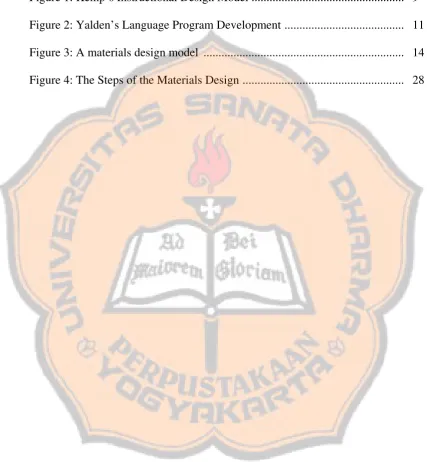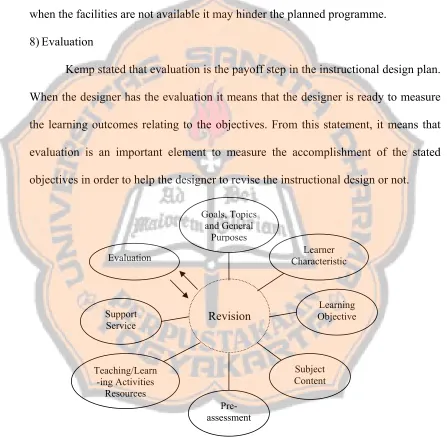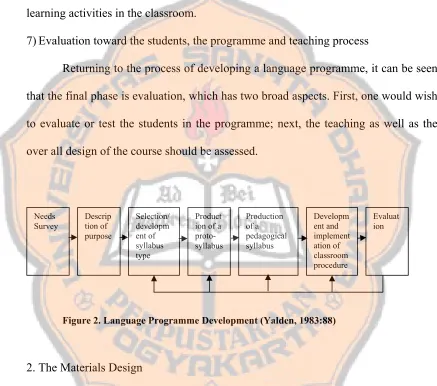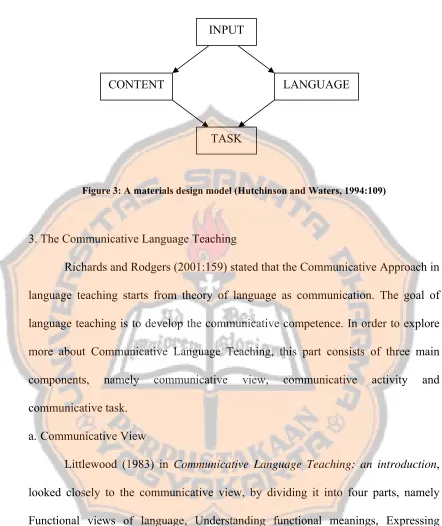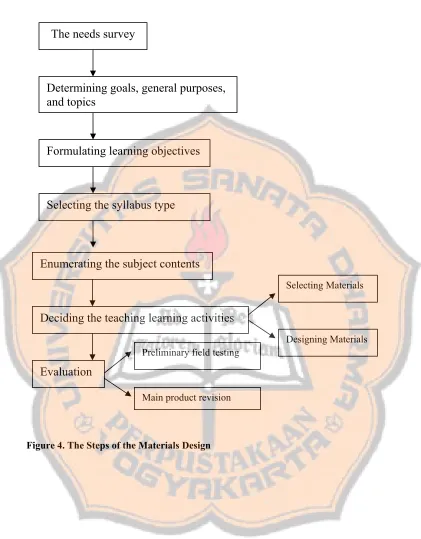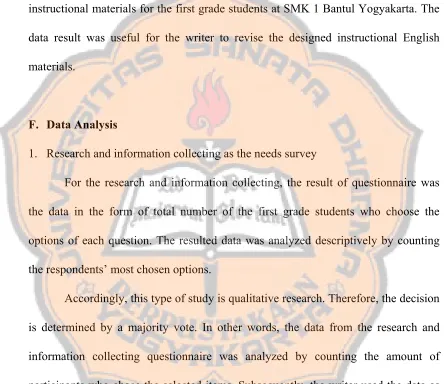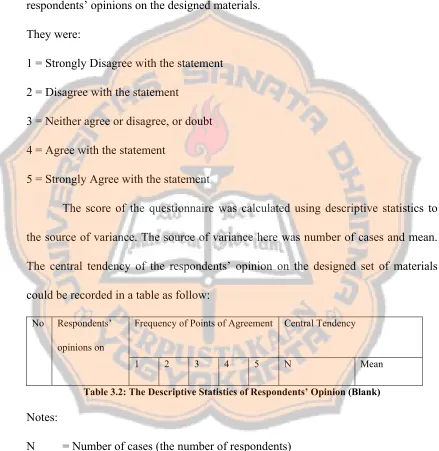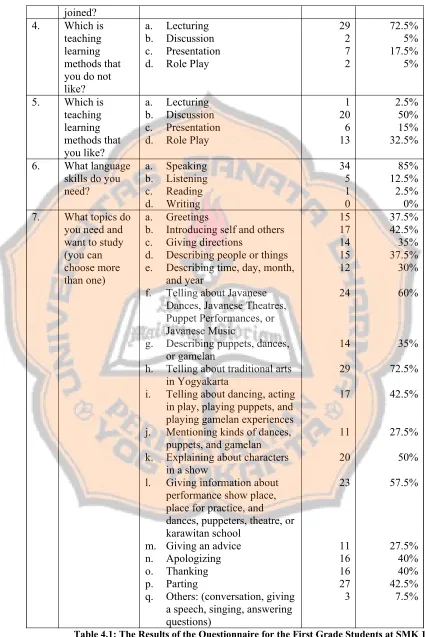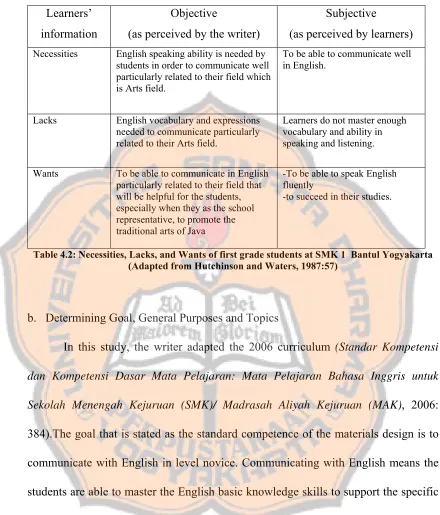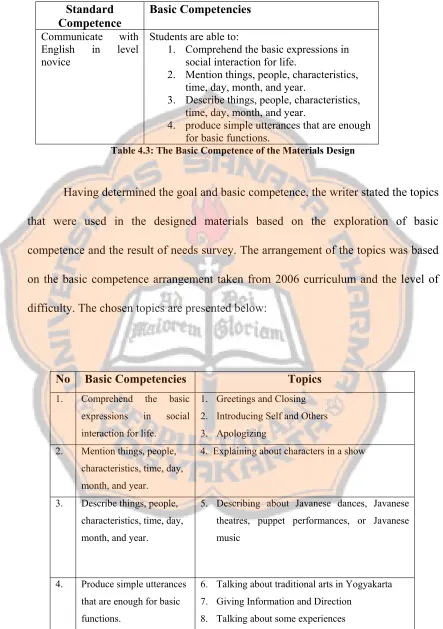ENGLISH INSTRUCTIONAL SPEAKING MATERIALS USING
COMMUNICATIVE TASKS FOR THE FIRST GRADE
STUDENTS OF SMK KESENIAN
A THESIS
Presented as Partial Fulfillment of the Requirements to Obtain the Sarjana Pendidikan Degree
in English Language Education
By
Winny Aditya Dewi
Student Number: 031214109
ENGLISH LANGUAGE EDUCATION STUDY PROGRAM DEPARTMENT OF LANGUAGE AND ARTS EDUCATION FACULTY OF TEACHERS TRAINING AND EDUCATION
SANATA DHARMA UNIVERSITY YOGYAKARTA
ENGLISH INSTRUCTIONAL SPEAKING MATERIALS USING
COMMUNICATIVE TASKS FOR THE FIRST GRADE
STUDENTS OF SMK KESENIAN
A THESIS
Presented as Partial Fulfillment of the Requirements to Obtain the Sarjana Pendidikan Degree
in English Language Education
By
Winny Aditya Dewi
Student Number: 031214109
ENGLISH LANGUAGE EDUCATION STUDY PROGRAM DEPARTMENT OF LANGUAGE AND ARTS EDUCATION FACULTY OF TEACHERS TRAINING AND EDUCATION
SANATA DHARMA UNIVERSITY YOGYAKARTA
2007
A Thesis on
God Will Make a Way
(Words and music by Don Moen)
God will make a way,
Where there seems to be no way
He works in ways we cannot see
He will make a way for me
He will be my guide
Hold me closely to His side
With love and strength for each new day
He will make a way, He will make a way.
By a roadway in the wilderness, He'll lead me
And rivers in the desert will I see
Heaven and earth will fade
But His Word will still remain
He will do something new today.
God will make a way,
Where there seems to be no way
He works in ways we cannot see
He will make a way for me
He will be my guide
Hold me closely to His side
With love and strength for each new day
He will make a way, He will make a way
ACKNOWLEDGEMENTS
First of all, I would like to express my biggest gratitude to my beloved God,
Jesus Christ for giving me this wonderful life and always accompanying me since I
was born up to present time. His hug and love help me to take even a small step in
my life.
My biggest gratitude goes to my major sponsor, Caecilia Tutyandari, S.Pd.,
M.Pd., for her time, advices and support that help me a lot finish my thesis. I am also
very thankful to my co sponsor, Fidelis Chosa Kastuhandani, S.Pd. His positive
ideas and sincere support help me much to deal with my thesis. I would also like to
address my thankfulness to Ag. Hardi Prasetyo, S.Pd, M.A., asthe Head of English
Study Programme. His help in lending me several books and giving me good advices
motivated me to finish this thesis.
My thankfulness goes to the big family of SMK 1 Kesenian Bantul
Yogyakarta in letting me doing my research in this fascinating school. I would also
to express my gratefulness to Michael Hadi Koesno, S.Pd, for introducing me to
SMK 1 Kesenian Bantul Yogyakarta. I would like to express my gratitude to the first
grade students at SMK 1 Kesenian Bantul Yogyakarta. I really enjoy our short
meeting. Your big appreciation in traditional arts motivates me to continue in doing
this thesis.
I would also want to express my biggest gratitude to my parents. My
gratefulness goes to my beloved Papa, Yohanes Anton Widodo for his caring, love
and support. Then, my gratefulness also goes to my lovely Mama, Maria Goreti
Kusmiyati, for giving me endless support, advices and prayer. Both of them are the
I would like to express my gratitude to my elder sister, Silvia Ayu Widayati,
for giving support and best advice that motivates me to face any obstacle in finishing
this thesis. My thankfulness also goes to my sister and brother, Francisca Imas
Soraya and Antonius Angga Christanto for sharing laughter and happiness that
brighten my life.
My sincere gratitude goes to my beloved friends, Sindu Lestari, Yessy and
Deni Kartika for giving endless support and sharing many good times together. My
thankfulness also goes to DanangW for lending me many books, giving advices and
ideas. His sincere help supports me to deal with this thesis. My gratitude goes to
Dudunk that help me with those beautiful pictures. I appreciate their helps.
My sincere thankfulness goes to Dialogue crews and big family of Baciro
Church for giving me new knowledge and experience. I would like to address my
thankfulness to the Secretariat staffs of the English Education Study Programme,
and the Library Staffs of Sanata Dharma University. I thank them for the
outstanding services.
I also thank to all people I can not mention here one by one, who had lent me
a hand to finish this thesis.
Winny Aditya Dewi
TABLE OF CONTENT
TITLE PAGE ... i
PAGE OF APPROVAL ... ii
PAGE OF DEDICATION... iv
STATEMENT OF WORK’S ORIGINALITY ... v
ACKNOWLEDGEMENTS ... vi
TABLE OF CONTENTS... viii
LIST OF TABLES ... xii
LIST OF FIGURES ... xiii
ABSTRACT... xiv
ABSTRAK... xv
I. CHAPTER I. Introduction A. Background... 1
B. Problem Formulation ... 3
C. Problem Limitation... 3
D. The Objectives of the Study ... 4
E. The Benefits of the Study ... 4
F. Definition of the Terms ... 5
II. CHAPTER II: Theoretical Review A. Theoretical Description ... 6
b. Yalden’s Model... 9
2. The Materials Design a. Defining objectives ... 11
b. Materials design model ... 12
3. The Communicative Language Teaching a. Communicative View ... 14
b. Communicative Activity ... 16
c. Communicative Competence ... 19
d. Communicative Task ... 20
4. The Speaking Skill a. The Nature of Speaking ... 22
b. Teaching Speaking ... 23
5. The 2006 Curriculum a. The Background of 2006 Curriculum... 23
b. The English Study Program 2006 Curriculum for Vocational High School ... 24
B. Theoretical Framework... 25
III.CHAPTER III: Methodology A. Method... 29
1. Research and Information Collecting ... 29
2. Planning ... 30
3. Developing a Form of Product... 30
4. Preliminary Field Testing ... 30
5. Main Product Revision... 31
B. Research Participants... 31
C. Setting ... 32
D. Research Instruments... 32
E. Data Gathering Technique ... 33
F. Data Analysis... 34
G. Research Procedure ... 36
IV.CHAPTER IV: Research Result and Discussion A. The Findings of the Study ... 38
1. The Result of the Needs Survey and the Implications ... 38
a. Conducting Needs Survey... 39
b. Determining Goals, General Purposes and Topics ... 43
c. Formulating Learning Objectives ... 45
d. Selecting the Syllabus Type ... 46
e. Enumerating the Subject Contents ... 47
f. Deciding the Teaching Learning Activities ... 48
2. Evaluation ... 48
a. Preliminary Field Testing ... 49
b. Main Product Revision ... 52
B. The Discussion of the Designed Materials ... 53
C. The Presentation of the Designed Materials ... 54
V. CHAPTER V: Conclusions and Suggestions A. Conclusions ... 56
B. Suggestions ... 58
APPENDICES
Appendix 1. Letter of Permission
Appendix 2. Needs Survey Questionnaires
Appendix 3. Questionnaires for Teachers
Appendix 4. General Description of the Designed Materials
Appendix 5. Syllabus
Appendix 6. Lesson Plan
Appendix 7. Presentation of the Designed Materials
LIST OF TABLES
Table 3.1: The result of the Needs Survey Questionnaires (blank) ... 34
Table 3.2: The Descriptive Statistic of Respondents’ Opinion (blank) ... 35
Table 4.1: The Results of the Needs Survey Questionnaires ... 39
Table 4.2: Necessities, Lacks and Wants ... 43
Table 4.3: The Basic Competence ... 44
Table 4.4: The Eight Topics ... 44
Table 4.5: The Indicators of the Students’ Performance ... 45
Table 4.6: The Description of Preliminary Field Testing Respondents... 49
Table 4.7: The Results of the Preliminary Field Testing Questionnaires ... 50
LIST OF FIGURES
Figure 1: Kemp’s Instructional Design Model ... 9
Figure 2: Yalden’s Language Program Development ... 11
Figure 3: A materials design model ... 14
Figure 4: The Steps of the Materials Design ... 28
ABSTRACT
Aditya, Winny. 2007. English Instructional Speaking Materials Using Communicative Tasks for the First Grade Students of SMK Kesenian. Yogyakarta: English Language Education Study Program, Sanata Dharma University.
The first grade students at SMK 1 Bantul, Yogyakarta could not speak English fluently. The problems occur when they had to promote Javanese art culture to foreigners. Considering the phenomenon, the writer tried to design a set of English instructional speaking materials for the first grade students at SMK 1 Bantul, Yogyakarta. Communicative task is chosen because it will encourage students to use language properly and speak as much as possible. There were two problems formulated in this study, they were:1) How is English instructional speaking materials using communicative tasks for the first grade students of SMK Kesenian designed? 2) What will the designed set materials look like?
The writer applied the RnD method in this study. Research information collecting was done for seeking the learners’ needs. Preliminary Field testing was done for getting the respondent’s evaluation on the designed materials.
ABSTRAK
Aditya, Winny. 2007. English Instructional Speaking Materials Using Communicative Tasks for the First Grade Students of SMK Kesenian. Yogyakarta: English Language Education Study Program, Sanata Dharma University.
Para siswa kelas 1 SMK 1 Bantul Yogyakarta tidak dapat berbahasa Inggris dengan lancar. Hal ini menyebabkan para siswa menemui kesulitan ketika mereka harus mempromosikan bahasa Inggris kepada orang asing.Melihat fenomena yang terjadi, penulis mencoba untuk mendesain satu set materi speaking untuk kelas 1 SMK 1 Bantul, Yogyakarta. Communicative tasks dipilih untuk menggalakkan siswa untuk menggunakan bahasa secara tepat dan berbicara sebanyak mungkin.Ada dua permasalahan yang diformulasikan di dalam studi ini. 1) Bagaimana mendesain satu set materi speaking menggunakan communicative tasks untuk kelas 1 SMK Kesenian? 2) Seperti apa desain tersebut?
Penulis mengaplikasikan metode RnD di studi ini. Pengambilan data penelitian dan informasi dilakukan untuk mencari kebutuhan siswa dalam berbahasa Inggris. Evaluasi pra-area dilakukan untuk mendapatkan evaluasi dari para responden tentang desain materi.
Untuk menjawab pertanyaan pertama, penulis mendesain materi dengan mengkombinasikan model RnD, Kemp dan Yalden. Langkah-langkahnya: 1) mengadakan survey kebutuhan siswa, 2) menentukan sasaran, tujuan umum dan topik, 3) memformulasikan indikator, 4) memilih tipe silabus 5) membuat subjek isi, 6) memilih aktivitas belajar-mengajar dan sumbernya, 7) evaluasi yang terdiri dari dua bagian yaitu evaluasi pra-area dan revisi produk utama.Untuk menjawab pertanyaan kedua, penulis meyajikan satu set materi, yang terdapat di Apendik 7, judulnya adalah ”Let’s Talk.”
CHAPTER I
INTRODUCTION
In this chapter, the writer presents the basic points related to the study, which
will be divided into six parts: Background, Problem Formulation, Problem
Limitation, the Objectives of the Study, Research Benefits, and Definition of Terms.
A. Background
The graduates of SMK 1 Bantul, Yogyakarta are already equipped to work in
the Arts field. The students are provided not only with the specific skill area that they
learn, but also with other subjects that will help the students to compete in the
working world. One of the subjects is English because nowadays people should be
able to master this language to compete in the working world. Because of the
awareness of mastering English in the working world, English is learnt in the
vocational high school and becomes a compulsory subject.
There are three language elements: grammar, vocabulary and pronunciation
and four basic skills: listening, speaking, reading, and writing that are taught in SMK
1 Bantul Yogyakarta. The students learn these four skills and based on the need after
they have graduated; speaking is measured as the basic need of the students because
the students need to communicate using English when they have to go abroad to
perform their art proficiency. The real fact is that many students do not master it and
they feel difficult to speak in English.
Moreover, Nunan (2003: 48) reveals that many people feel that speaking in a
new language is harder than other skills for two reasons. First, unlike reading or
talking to is waiting for listener to speak right then. Second, when the speaker
speaks, the speaker cannot edit and revise what the speaker wishes to say, as the
speaker can if the speaker is writing. This difficulty happens at SMK 1 Bantul
Yogyakarta since the students have the obstacle when they want to master speaking
skill.
The obstacle faced by most of the students at SMK 1 Bantul Yogyakarta who
are going abroad in order to promote Indonesian culture happens when they have to
speak in English. Therefore, speaking is considered important skills for the learners.
Speaking skill is important because the mastery of English is closely related to
communication.
Related to the need for communicative proficiency, a communicative
approach or communicative language teaching is appropriate to develop speaking
skill. Communicative Language Teaching (CLT) is an approach to the teaching of
second and foreign languages that emphasizes on interaction as both the means and
the ultimate goal of learning a language
(http://en.wikipedia.org/wiki/communicative_language_teaching).
Larsen-Freeman (2000: 121) points out that communicative language
teaching aims broadly to apply the theoretical perspective of the communicative
approach by making communicative competence the goal of language teaching and
by acknowledging the interdependence of language and communication. The
underlying theory of CLT approach is the communicative competence (Hymes,
1971). Students do not simply learn the linguistic structures and grammar rules. They
The communicative tasks are important for the students to develop their
speaking skill. Nunan (1989: 10) defines communicative task as a piece of classroom
work which involves learners in comprehending, manipulating, producing or
interacting in the target language while their attention is principally focused on
meaning rather than form. Through doing speaking exercises based on the
communicative tasks, such as role play, interviews, information gap, games, and pair
work, students are encouraged to express what they have learnt orally. Therefore in
this study, the writer designs a set of instructional material using communicative
tasks for the first grade students at SMK 1 , Bantul, Yogyakarta.
B. Problem Formulation
There are two problems in this study. They can be formulated as follow:
1. How is English speaking instructional materials using communicative tasks for
the first grade students of SMK Kesenian designed?
2. What will the designed set materials look like?
C. Problem Limitation
In this study, the writer intends to design a set of instructional speaking
materials using communicative tasks. The writer mainly focuses on the instructional
speaking materials design because the students need to improve their speaking
ability. The design is made for the first grade students at SMK 1 Bantul Yogyakarta
who study arts, particularly Javanese arts (Javanese Dance Arts, Javanese Theatre
Arts, Puppet Performance Arts, and Javanese Music Arts). The writer obtained the
and information collecting is to find out the students’ want, particularly for the topics
that are correlated with the arts field. Thus, this design is presented to help the
students to master their speaking skill, particularly which is interconnected to the arts
field.
D. The Objectives of the Study
There are two objectives of the study:
1. To construct English instructional speaking materials using communicative tasks
for the first grade students of SMK Kesenian.
2. To present the designed set of materials.
E. The Benefits of the Study
This research is expected to be helpful first for English teacher at SMK 1
Bantul, Yogyakarta and other teachers at vocational high schools of arts in which the
designed materials will help the teacher to conduct a lively teaching-learning process
in class. Moreover, the designed materials will help the teacher to use the tasks that
are appropriate and effective for the learners to achieve the goal of learning the target
language.
Second, the designed materials are very helpful for the first grade students at
SMK 1 Bantul, Yogyakarta because of several points which are: the designed
materials will make the students enjoy learning English; the designed materials will
help the students to improve their speaking ability; the designed materials will bring
meaningful learning to the students; the designed materials will make effective
learning activities; the designed materials will make the students be interested in
F. Definition of Terms
1. Instructional Material Design
Kemp (1977: 6) points out that instructional material design is composed of
any interrelated parts and functions in order to achieve goals. In this study,
instructional material design is what the writer will design according to the data
taken from the research and information collecting that the writer will conduct.
2. Speaking
Nunan (2003: 48) states that speaking is the productive oral skill. It consists
of producing systematic verbal utterances to convey meaning. In this study, speaking
means how the students use the language, how the students can choose the right
expression, and how the students can produce oral utterances and practice it.
3. Communicative Tasks
Nunan (1989: 10) defines communicative task as a piece of classroom work
which involves learners in comprehending, manipulating, producing or interacting in
the target language while their attention is principally focused on meaning rather
than form. In this study, communicative task means a task that is given by the teacher
to the students in order to improve the students’ communicative competence.
4. Arts Vocational High School (SMK Kesenian)
Vocational education deals with “knowledge, skills and attitudes that fit an
individual, wholly or in part, for definite occupation or vocation, the pursuit of which
equips for successful living” (F. Theodore Struck, 1945: 5). In this study, arts
vocational high school is a school that deals with the arts field knowledge, skills and
CHAPTER II
THEORETICAL REVIEW
This chapter presents the theories that are going to be used in the study. It
consists of two parts, namely theoretical description and theoretical framework.
A. Theoretical Description
This section reviews some theories as the guideline to conduct this study. It is
divided into four main parts. They are Instructional Design Models, Materials
Design, Communicative Language Teaching, and Speaking Skill.
1.Instructional Design Models
In order to design English instructional materials, this study uses two models
of instructional design, namely: Kemp’s model and Yalden’s model.
a.Kemp’s model
Kemp (1977: 4) stated that successful innovation in education requires at
least three major elements. The first element is the teachers who are deeply
concerned about their teaching effectiveness and who are motivated by a desire for
improvement. The second is the administrators who willingly encourage and support
those teachers and the last element is a carefully designed plan for developing
improved instructional practice.
The problems appeared when the last element, which is a designed plan is
developed in terms of traditional instructional approach. Therefore, Kemps (1977: 8)
divided the instructional design models into eight steps that can be best applied to
individual topics and to units and then to complete courses. The eight plans can be
described as follows:
1)Goals, Topics, and General Purposes
Kemp stated that instructional design planning starts with recognition of the
broad goals of the school system or institution. The educational programme is then
developed to serve those goals. Within curriculum areas or courses, topics are chosen
for study, for each of which the teacher explicitly expresses the general purposes
(what students generally are expected to learn as a result of instruction).
From this statement, it can be said the steps starting from goals derived from
the school system, then it moves to the selection of the topics that is interconnected
with the curriculum, then it moves to the selection of the general purposes that are
chosen by the teacher concerning with the students’ needs.
2)The Learners’ Characteristics
Kemp stated that to best assure an individual’s success in the designer’s
educational programme, the designer should recognize and respect the students as
individual learners. Here, Kemp divides the learners’ characteristic into two factors,
which are academic and social factors.
It means that by knowing the learners’ characteristic, it will help to achieve
the goal, topics, and general purposes that have been stated in the first step. In other
word learners’ characteristics are very important to guarantee the success of the
educational programme.
3)Learning Objectives
Kemp said that learning requires active effort by the learner. Thus, all
means that a good teacher should bring the objectives in his class to the students to
show the students the relevance between the objectives and what topics they are
studying.
4)Subject Content
Kemp stated that a student’s learning experiences must involve subject
content. The content, in turn, must be closely related to the objectives and to the
student’s needs. In other words, the subject content should be included in the steps of
designing the materials because it is closely interconnected with the objectives and
the students’ needs.
5)Pre-assessment
Kemps said that in order to know the readiness of the students to study topic,
unit and competence of the students in the stated objectives the educational
programmer should have a placement and diagnostic tests as ways of determining the
students’ background in the subject and as guides for grouping them.
From this statement, it can be said that placement and diagnostic test will be
helpful for the educational programmer to re-examine the topics and the stated
objectives in order to help the designer to group the students based on their
background knowledge.
6)Teaching/Learning Activities, Resources
Kemp stated that the educational programmer must determine the most
efficient and effective methods and then select materials to provide learning
experiences that will utilize the content associated with each objective. In other
words, selecting the teaching learning activities is important in order to achieve the
7)Support Services
Kemp included funds, facilities, equipment, and personnel whose time must
be scheduled for participation in the instructional plan. It can be said that the
facilities that are stated by Kemp support the teaching learning activities because
when the facilities are not available it may hinder the planned programme.
8)Evaluation
Kemp stated that evaluation is the payoff step in the instructional design plan.
When the designer has the evaluation it means that the designer is ready to measure
the learning outcomes relating to the objectives. From this statement, it means that
evaluation is an important element to measure the accomplishment of the stated
objectives in order to help the designer to revise the instructional design or not.
Revision
Learner Characteristic
Learning Objective
Subject Content
Pre-assessment Teaching/Learn
-ing Activities Resources
Evaluation
Support Service
Goals, Topics and General
Purposes
Figure 1. Models of Instructional System (Kemps, 1977: 9)
b.Yalden’s model
Yalden (1983: 88) divided the instructional design into seven steps, which
1)Need survey
According to Yalden, when a need survey is being undertaken there is
potentially a great deal of information to be gathered. The reason for this entire
information gathering is to understand as much about the learners as possible prior to
the beginning of the programme in order to establish realistic and acceptable
objectives.
2)Description of purpose
Here, the next step for the system designer is to clarify the purpose of the
language programme. This will establish the foundation for the major decision facing
the language course designer when he arrives in the stage III, the selection of a
syllabus type.
3)Selection or development
Here, Yalden implied that no single model of syllabus design which is
universally agreed upon. It means that the designer should realize the strengths and
the weaknesses of the syllabus design that is being taken or the designer can combine
more than one syllabus in order to make the course design more reliable.
4)The proto syllabus
At this stage, the syllabus designer will turn to the description of the content
that the syllabus will have, that is the preparation of syllabus specifications. In other
words, the designer will examine the syllabus that is chosen.
5)The pedagogical syllabus
In this step, the pedagogical syllabus provides a repertoire of words and
phrases, chosen as exponents of functions and suitable to the topics identified as
6)Development and implementation of classroom procedure
In this step, the designer can develop the syllabus design in order to get the
syllabus that is relevant with the communicative language teaching. Not only
develop the syllabus, but the teacher also implies the syllabus into the teaching and
learning activities in the classroom.
7)Evaluation toward the students, the programme and teaching process
Returning to the process of developing a language programme, it can be seen
that the final phase is evaluation, which has two broad aspects. First, one would wish
to evaluate or test the students in the programme; next, the teaching as well as the
over all design of the course should be assessed.
Needs Survey Descrip tion of purpose Selection/ developm ent of syllabus type Product ion of a proto-syllabus Production of a pedagogical syllabus Developm ent and implement ation of classroom procedure Evaluat ion
Figure 2. Language Programme Development (Yalden, 1983:88)
2.The Materials Design
According to Hutchinson and Waters (1994: 107) there are two main parts in
materials-producing techniques, namely defining objectives and materials design
model. Those can be described as follow:
a.Defining objectives
In defining the purpose of the materials, the designer can identify some
1)Materials provide stimulus to learning. Good materials do not teach; they
encourage learners to learn.
2)Materials help to organise the teaching learning process, by providing a path
through the complex mass of the language to be learnt. Good materials should
provide a clear and coherent unit structure which will guide teacher and learner
through various activities in such a way to maximise the chances of learning.
Therefore, a materials model must be clear and systematic, but flexible enough to
allow for creativity and variety.
3)Materials embody a view of the nature of language and learning. Therefore,
materials should truly reflect what the author thinks and feels about the learning
process.
4)Materials reflect the nature of the learning task. The designer must now take a
more modest view and recognise that language learning is very complex and little
understood process. For that reason, materials should try to create a balanced
outlook which both reflects the complexity of task, yet makes it appear
manageable.
5)Materials can have a very useful function in broadening the basis of teacher
training, by introducing teachers to new techniques.
6)Materials provide models of correct and appropriate language use. The last
principle is the necessary function of materials, but it is not the only purpose that
makes the result of materials become simply a statement of language use rather
than a vehicle for language learning.
b.Materials design model
Hutchinson and Waters (1994: 108) stated that the materials design model
1)Input
This may be a text, dialogue, video-recording; diagram or any piece of
communication data, depending on the needs the teacher has defined in the analysis.
The input provides a number of things which are stimulus material for activities, new
language items, correct models of language use, a topic for communication;
opportunities for learners to use their information processing skills, and opportunities
for learners to use their existing knowledge both the language and the subject matter.
2)Content focus
Language is not an end itself, but a means of conveying information and
feelings about something. Non-linguistic content should be exploited to generate
meaningful communication in the classroom.
3)Language Focus
The aim is to enable learners to use language, but it is unfair to give learners
communicative tasks and activities for which the learners do not have enough of the
necessary language knowledge. In language focus learners have the chance to take
the language to pieces, study how it works and practise putting it back together
again.
4)Task
The ultimate purpose of language learning is language use. Materials should
be designed, therefore, to lead towards a communicative task in which learners use
INPUT
TASK
LANGUAGE CONTENT
Figure 3: A materials design model (Hutchinson and Waters, 1994:109)
3.The Communicative Language Teaching
Richards and Rodgers (2001:159) stated that the Communicative Approach in
language teaching starts from theory of language as communication. The goal of
language teaching is to develop the communicative competence. In order to explore
more about Communicative Language Teaching, this part consists of three main
components, namely communicative view, communicative activity and
communicative task.
a.Communicative View
Littlewood (1983) in Communicative Language Teaching: an introduction,
looked closely to the communicative view, by dividing it into four parts, namely
Functional views of language, Understanding functional meanings, Expressing
functional meanings, and Understanding and expressing social meanings.
1)Functional views of language
Littlewood (1983) stated language is used as a means of communication.
Therefore, functions view which concern on the specific situational and social factors
into a number of functions, so also can a single communicative function be expressed
by a number of linguistic forms. It means that the speaker can use many linguistic
options when he wants to say one meaning.
2)Understanding functional meanings
Littlewood (1983) stated that there are three corresponding aspects of the skill
involved in understanding meanings. First is the ability to understand linguistic
structures and vocabulary. Second is knowledge of the potential communicative
functions of linguistic forms. Third is the ability to relate the linguistic forms to
appropriate non-linguistic knowledge, in order to interpret the specific functional
meaning intended by the speaker.
Those three aspects reveal that the hearer should comprehend not only the
linguistic knowledge but also the relation to the specific functional meaning. The
foreign language learners should be able to develop the strategies to understand the
meaning of what the speaker wants to say in order to achieve the communicative
functions.
3)Expressing functional meanings
Littlewood (1983) stated that communication is a two-sided process. When
someone speaks, the speaker is constantly estimating the hearer’s knowledge and
assumptions, in order to select language that will be interpreted in accordance with
our intended meaning.
Due to his statement, it can be said that the speaker must master the
functional views. The speaker should realize the hearer’s background knowledge, the
social situation that is involved in the communication process. Moreover, the speaker
effectively. Related to the foreign language learners, they need to acquire not only
the linguistic knowledge but also the strategies that can help them to communicate
effectively in a real situation.
4)Understanding and expressing social meanings
Littlewood (1983) said that one factor determining the speaker’s choice of
language is the knowledge that he assumes the hearer to possess. A further important
factor is his interpretation of the social situation in which communication is taking
place: language carries not only functional meaning, it also carries social meaning.
Therefore, it can be said that if we want to communicate with someone, we
have to be able to comprehend the functional view and the strategy that can make the
hearer understand of what we are intended to say as the speaker. Furthermore, the
speaker should be able to read the social situation that happens in the communication
process.
b.Communicative Activity
Littlewood (1983) stated that the teacher may have designed the activity so as
to provide an opportunity for the learners to produce language that they had already
learnt so that it can lead the learners to communicate meanings effectively. Due to
the statement, this part will approach the communicative activity by describing the
purposes of communicative activities,
1)Purposes of Communicative Activities
This part consists of what the teacher might hope to achieve, through
communicative activity in the classroom, therefore the following four headings are
the summary of the contributions that communicative activity can make to language
a)Communicative activities provide ‘whole-task practice’
Littlewood (1983) stated in foreign language learning, the means for
providing learners with whole-task practice in the classroom is through various kinds
of communicative activity, structured in order to suit the learners’ level of ability.
Thus, through the various communicative activities, the learners can be provided the
whole task practice that is suitable on their level ability in order to make the learners
easier to achieve the goal of the lesson.
b)Communicative activities improve motivation
Litlewood (1983) defined that the learner’s ultimate objective is to take part
in communication with others. Their motivation to learn is more likely to be
sustained if they can see how their classroom learning is related to the objective and
helps them to achieve it with increasing success.
It means that communicative activities can make the learners motivate
themselves in learning the target language by providing the relevance between the
learning activities and the objectives. By being motivated, the learners can help
themselves to achieve the objectives of the classroom activity that is to communicate
with others using the target language.
c)Communicative activities allow natural learning
Littlewood (1983) revealed that many aspects of language learning can take
place only through natural processes, which operate when a person is involved in
using the language for communication. It can be said that communicative activities is
important in the learning process because they provide the learners to use the natural
d)Communicative activities create a context which supports learning
Communicative activity provides opportunities for positive personal
relationships to develop among learners and between learners and teacher. These
relationships can help to ‘humanise’ the classroom and to create the environment that
supports the individual in his efforts to learn. It means that communicative activities
develop the relationship between the learners and the teachers so that it will build a
conducive classroom environment that will support or motivate the learners to make
a progress of their language learning process.
2)Learner-directed Activity
Littlewood (1983) stated that in many communicative activities the teacher
creates a situation and sets an activity in motion, but it is the learners themselves who
are responsible for conducting the interaction to its conclusion. From this statement,
it can be said that in communicative activities, there will be a learner-centred
approach. Therefore, the learners should actively take part in every activity in order
to make the communicative activity runs effectively. The teacher is only a facilitator.
3)The Teacher’s Role in Communicative Activities
Littlewood (1983) stated that especially in the more creative types of activity,
unnecessary intervention on the teacher’s part may prevent the learners from
becoming genuinely involved in the activity and thus hinder the development of their
communicative skills. However, this does not mean that once an activity is in
progress, the teacher should become a passive observer. His function becomes less
dominant than before, but not less important.
From this statement, it can be said that the teacher’s role in the
the students become active and monitor the students’ development in performing
their language ability.
4) Types of Communicative Activities
Littlewood (1983) divided the communicative activities into two types; they
are functional communication activities and social interaction activities.
• Functional communication activities
The main purpose of this activity is that learners should use the language they
know in order to get meanings across as effectively as possible. In other words, it can
be said that how the learners can communicate with others related to the situation
that happens.
• Social interaction activities
We can devise communication activities which place emphasis on social as
well as functional aspects of communication. In other words the learners should
focus not only in the terms of the functional effectiveness of the language, but also in
terms of the social context in which the interaction takes place.
c.Communicative Competence
Paulston and Bruder (1976: 55) stated that generally communicative
competence is taken to be the objective of language teaching: the production of
speakers competent to communicate in the target language. Francis Johnson as
quoted by Paulston and Bruder (1976: 56) pointed out that communication requires
interpersonal responsiveness, rather than the mere production of language which is
truthful, honest, accurate, etc. Communication arises when language is used as
Dell Hymes as cited by Paultson and Bruder (1976: 56) argued that
communicative competence must include not only the linguistic forms of language
but also knowledge of communicative function itself such as when, how and to
whom it is appropriate to use the language.
d.Communicative Task
For communicative tasks, Nunan (1989: 10) has offered this definition: “the
communicative task is a piece of classroom work which involves learners in
comprehending, manipulating, producing or interacting in the target language while
their attention is principally focused on meaning rather than form.” According to
Steven Tait, M.Ed. TESOL
(http://www.englishclub.com/tefl-articles/successful-communicative-tasks) communicative activities are fluency-based activities. While
such activities may involve students practicing a particular grammatical form, they
are likely to do more than this. The key element is that the activity is based around a
realistic situation. It means that in communicative activities, students learn language
related to the real situations that are closely related with the student’s everyday
experiences.
Nunan (1989) stated the framework for analyzing communicative tasks.
Goals Teacher role
Input TASKS Learner Role
Goals may relate to a range of general outcomes (communicative, affective or
cognitive) or may directly describe teacher or learner behaviour. We can know goal
from an examination of a task. Input is a task consists of some input and one or more
related activities. Input refers to the data from the point of departure for the task. In
fact, input for communicative tasks can be gathered from a wide range of sources.
Activities specify what learners will actually do with the input as the beginning of
learning task. Pattison as cited by Nunan (1989: 68) proposes seven activities types.
Those activities are as follows:
1)Questions and answers
These activities are based on the notion of creating an information gap. The
aim of this activity is for learners to discover their classmates’ secret choices. This
activity can be used to practice almost any structure, function, or notion.
2)Dialogues and role-play
If learners are given some choice of what to say, and if there is a clear aim to
be achieved by what they say in their role-plays, the learners may participate more
willingly and learn more thoroughly than when they are told to repeat a given
dialogue in pairs or in a group.
3)Matching activities
The task for the learner is to recognize matching items, or to complete pairs
or sets.
4)Communication strategies
These activities are designed to encourage learners to practice communication
5) Picture and Picture stories
Many communication activities can be stimulated through the use of pictures.
6)Puzzles and problems
These require learners to make guess, draw their general knowledge and
personal experience, use their imagination and test their powers of logical reasoning.
7)Discussion and decisions
These require the learners to collect and share information to reach a
decision.
4.The Speaking Skill
Here, in order to draw near with speaking skill, the writer will divide it into
two, namely the nature of speaking and teaching speaking.
a.The nature of speaking
Rivers (1970) stated that students come to the study of a foreign language in
high school with the strong conviction that language means something spoken.
Through speech, man expresses his emotions, communicates his interactions, reacts
to other persons and situations, and influences other human beings.
Brown and Yule as cited by Nunan (1989: 26) stated that spoken language
consist of short, often fragmentary utterances, in a range of pronunciations.
Moreover, speaking has the interactional function, in which the primary purpose of
speech is the maintenance of social relationship.
b.Teaching speaking
Rivers (1970) stated that the teaching of the speaking skill is more demanding
speaking is that the teacher will need to give the students many opportunities to
practice the speaking skill. The teaching of the speaking skills involves two levels of
activity; the first is the forging of the instrument requires much practice in the
arbitrary associations of the new language. Second, the student who is to speak a
language so as to express his personal meaning needs much practice in this process
of generating new sentences to suit his purpose.
Hughes (2002) stated that teaching speaking is not easily separated from
other objectives. A further complicating factor is that when the spoken language is
the focus of classroom activity there are often other aims which the teacher might
have: for instance, helping the students to gain or practice some aspects of linguistic
knowledge or to raise awareness of some socio-linguistic or pragmatic point (the
communicative functions)
5. The 2006 Curriculum
Based on the Education Ministry Degree number 22 year 2006 about content
standard and number 23 year 2006 about graduated competence standardisation, the
writer used the 2006 curriculum, (Pusat Kurikulum Balitbang Depdiknas, 2006) as
the basic for designing the instructional materials. Here, in order to get close with the
2006 curriculum, the writer will divide it into two, namely the background of 2006
curriculum and English Study Program 2006 Curriculum for Vocational High
School.
a. The Background of 2006 Curriculum
Based on Pusat Kurikulum Balitbang Depdiknas (Kurikulum Tingkat Satuan
and implemented by each education unit. It has three main purposes. First,
elementary education has a purpose to put the basic cleverness, knowledge,
personality and the ability to live independently and continue it into higher level.
Second, intermediate education has a purpose to increase cleverness, knowledge,
personality and the ability to live independently and continue it into higher level.
Third, vocational elementary education has a purpose to increase cleverness,
knowledge, personality and the ability to live independently and continue it into
higher level based on their specific field.
The 2006 curriculum is a form of the basic and intermediate curriculum. It is
developed based on each group or education unit and school committee or madrasah
under the coordination and supervision of education and religion ministry for basic
education and province for intermediate education. The basic of this curriculum is on
the content (Education Ministry Degree number 22 year 2006) and graduated
competence standardisation (Education Ministry Degree number 23 year 2006) that
is designed by the National Education Standards Boards (BNSP).
b. English Study Program 2006 Curriculum for Vocational High School
Based on the 2006 curriculum (Standar Kompetensi dan Kompetensi Dasar
Mata Pelajaran: Mata Pelajaran Bahasa Inggris untuk Sekolah Menengah Kejuruan
(SMK)/ Madrasah Aliyah Kejuruan (MAK), 2006: 384), Language is a device to
communicate with others both oral and written. Enable to communicate means the
person is able to comprehend or produce oral and written sentences. Enable to use
language covers listening, speaking, reading and writing skills that can be used for
English is an adaptive study programme. The purpose is to provide the
students with the ability to communicate in English both oral and written which is
suitable with their specific field. English study programme is expected to help the
students to master Basic English knowledge and skills for supporting the specific
field achievement. It also has an intention to implement the students’ ability to
communicate both oral and written at intermediate level.
The scope of English study programme at vocational high school curriculum
covers three aspects. First is basic English communication in novice level which is
for the first grade students. Second is basic English communication in elementary
level which is for the second grade students. Third is basic English communication in
intermediate level which is for the third grade students.
B.THEORETICAL FRAMEWORK
Due to the need of communicative proficiency, a communicative approach or
communicative language teaching is appropriate to develop speaking skill.
Therefore, in this study the writer will design the instructional materials for teaching
speaking using communicative tasks in order to improve the students’
communicative competence in order to accomplish the class’ objective in learning
English related to the arts field.
Here, the writer will combine two models of instructional design (Kemp and
Yalden) in order to make the best design that is appropriate for the first grade
students at SMK Kesenian 1 Kasihan Bantul Yogyakarta. These two models are
chosen because they have the steps that are particularly important to design the
instructional materials. These steps will be used by the writer to make the
1. The needs survey (Yalden)
The first step in designing the materials is the needs survey. Based on RnD
cycle, it can be considered as research information collecting. The writer distributed
the questionnaire into 40 first grade students at SMK 1 Bantul Yogyakarta. It is
aimed to gather the research data that will be needed by the designer in order to state
the realistic goal, topics and general purposes.
2. Determining goals, general , and purposes topics (Kemp)
After the designer gets the data and analyses it in order to get the data result,
the designer determines the goals or standard competence and formulates the general
purposes or it can be said as basic competence based on 2006 curriculum for
vocational high school. Then, the designer selects the topics taken from the research
and information collecting and based on basic competence exploration.
3. Formulating learning objectives (Kemp)
Kemp stated that learning requires active effort by the learner. Thus, all
objectives must be stated in terms of activities that will best promote learning. Due to
the statement, the designer formulates learning objectives which is the indicators in
order to show the relevance between the objectives and what the subject content that
will be used.
4. Selecting the syllabus type (Yalden)
After deciding the Indicators, the next step is choosing syllabus type. Yalden
stated that there is no single model of syllabus design which is universally agreed
upon. Therefore, various combinations are possible, and of course various focuses on
5. Enumerating the subject contents (Kemp)
Kemp stated that a student’s learning experiences must involve subject
content. Therefore, the designer enumerates the subject content that is closely related
to the objectives and the students’ needs.
6. Deciding the teaching learning activities and resources (Kemp)
In this step, the designer decides the instructional methods and instructional
resources that will be most appropriate for accomplishing each objective. The
designer not only determines the most efficient and effective methods and then select
materials to provide learning experiences that will develop the content associated
with each objective but also designs the instructional materials.
7. Evaluation (Kemp)
Here, the designer combines the steps from Kemp and Educational research
and development. There are two sub-steps in this last step:
a.Preliminary Field Testing
In order to measure the quality of the material design, the designer should get
the feedback of performance data into the system from the evaluators for the purpose
of making adequate adjustments in system. Here, the designer distributes
questionnaire to the teachers in order to make the designed materials improvement.
b.Main Product Revision
After the designer obtains the preliminary field testing result, the writer
revises, improves, or changes some parts based on the result of preliminary field
The needs survey
Determining goals, general purposes, and topics
Formulating learning objectives
Selecting the syllabus type
Evaluation
Deciding the teaching learning activities Enumerating the subject contents
Selecting Materials
Designing Materials Preliminary field testing
Main product revision
CHAPTER III
METHODOLOGY
This chapter discusses the methodology that was used to answer two
questions stated in the problem formulation. The discussion includes methods that
were used, research participants, setting, research instruments, data gathering
technique, data analysis, and also research procedure.
A. Method
Educational research and development (R and D) is a process used to develop
and validate educational products. Moreover, the goal of R and D is to take the
research knowledge and incorporate it into a product that can be used in school (Borg
and Gall, 1983: 771). Therefore, the writer conducted an educational research and
development to obtain the data for this study. In conducting the research the writer
used research and information collecting, planning, development of product,
preliminary field testing and main product revision.
1. Research and information collecting
Based on R and D cycle (Borg and Gall, 1983: 774), research and information
collecting takes the first part. Here, the writer also put research and information
collecting as the first part. The writer distributed the questionnaire into 40 first grade
students at SMK 1 Bantul, Yogyakarta in order to collect all necessary information
from the students at SMK 1 Bantul, Yogyakarta to support this study. The writer did
the research and information collecting in order to do the need analysis. The writer
distributed questionnaire that contained the questions about the kind of English
The research and information collecting focused on several things:
a. The appropriate speaking topic related to the Arts field
b. The contents of materials which are appropriate for the students at SMK 1
Bantul, Yogyakarta.
c. The kinds of strategy that is appropriate for the students at SMK 1 Bantul,
Yogyakarta.
2. Planning
Here, the writer made some plans before developing a product. The writer
determined goals or standard competence and general purposes or basic
competencies based on the 2006 curriculum. Then, the writer determined the topics
based on the exploration of basic competence and research information collecting
result. Next, the writer formulated the learning objectives or indicators.
3. Developing a form of product
Developing a form of product took the major part in materials development.
After the writer collected the research and information collecting, and made some
plans the writer used the result to develop form of product which is selecting the
syllabus type. Then the writer enumerated the subject contents that was helpful for
the writer to develop the product which was designing the materials.
Next, the writer designed speaking materials for the first grade students at
SMK 1 Bantul, Yogyakarta. The writer used the research and information collecting
result and the 2006 curriculum as the basic for developing the materials.
4. Preliminary field testing
Here, the writer distributed the questionnaire to three teachers at SMK 1
helpful to make a main product revision. The objective of preliminary field testing
was to get the opinion and evaluation from the research participants in order to revise
and improve the designed materials. The writer distributed the questionnaire after the
writer designed the materials in order to know some information about whether:
a. the basic competence and indicators were formulated correctly.
b. the designed materials have accomplished the students’ needs.
c. the topics of the designed materials were appropriate based on the student’s level
and interesting for the students.
d. the tasks were appropriate to accomplish basic competence and indicators.
e. the designed materials were appropriate for the first grade students at SMK 1
Bantul Yogyakarta.
5. Main product revision
After the writer gained the comments and feedback from the three teachers at
SMK 1 Bantul Yogyakarta, the writer revised the designed materials based on their
comments and feedback.
B. Research Participants
The participants of this study were divided into two; those were research and
information collecting participants and preliminary field testing participants.
1. Research and information collecting participants
Since the purpose of the research information collecting is to know the
students’ needs, lacks and wants, therefore the target population for the research
participants was the first grade students at SMK 1, Bantul Yogyakarta. Since the
at SMK 1 Bantul Yogyakarta. The writer tried to obtain the accessible population for
two speaking classes. Furthermore, the sample of this research took for about 40
students from 53 students at speaking classes.
2. Preliminary field testing participants
There are three English teachers at SMK 1 Bantul Yogyakarta. Therefore, the
group of respondents for the preliminary field testing was all those three teachers at
SMK 1 Bantul Yogyakarta because the teachers have much knowledge and many
experiences in selecting the materials that are appropriate for vocational high school
students particularly the first grade students at SMK 1 Bantul Yogyakarta. The
questionnaire was needed in order to gather information, comments, suggestions and
opinion of the designed material that were needed in order to improve and revise the
designed materials.
C. Setting
The place for conducting the study was in SMK 1 Bantul, Yogyakarta. The
time for the research was in the even semester in 2007. For the questionnaire, the
writer distributed the questionnaire of research and information collecting to the
students on the even semester in 2007. The writer distributed the questionnaire of
preliminary field testing after the writer developed the form of product.
D. Research Instruments
There were two kinds of survey that the writer used in the study:
1. Research and information collecting instrument
The writer employed questionnaire for the survey study. A questionnaire is a
get facts or information, or for a survey (Oxford Advanced Learner’s Dictionary,
1987: 688). Moreover, Seliger and Shohamy (1989: 72) stated that questionnaires are
printed list for data collection, which contain questions or statements for the subject
to respond.
There was one group of participants for questionnaire which was the first
grade students at SMK 1 Bantul Yogyakarta. The writer distributed the questionnaire
that was helpful for the writer to find out the students’ needs, lacks and wants, the
kind of teaching speaking instructional materials that the students were interested in.
2. Preliminary field testing
After the writer designed English speaking instructional materials, the writer
distributed the questionnaire to the three teachers at SMK 1 Bantul Yogyakarta in
order to evaluate the strengths and the weaknesses of the design. The data result was
useful for the writer to revise the instructional materials.
E. Data Gathering Technique
1. Research and information collecting data
For research and information collecting, the writer distributed the
questionnaire to one group of participants. The participants were the first grade
students at SMK 1 Bantul Yogyakarta in order to collect the research and
information for research and information collecting. The writer distributed the
questionnaire to the students in order to know the students’ needs, lacks and wants,
what kind of teaching speaking instructional materials that the students were
interested in. The data result from the questionnaire was used for the data analysis in
2. Preliminary field testing
The data taken from the three teachers was very helpful for the writer to make
main product revision. The writer distributed the questionnaire to the three teachers
in order to evaluate the strengths and the weaknesses from English speaking
instructional materials for the first grade students at SMK 1 Bantul Yogyakarta. The
data result was useful for the writer to revise the designed instructional English
materials.
F. Data Analysis
1. Research and information collecting as the needs survey
For the research and information collecting, the result of questionnaire was
the data in the form of total number of the first grade students who choose the
options of each question. The resulted data was analyzed descriptively by counting
the respondents’ most chosen options.
Accordingly, this type of study is qualitative research. Therefore, the decision
is determined by a majority vote. In other words, the data from the research and
information collecting questionnaire was analyzed by counting the amount of
participants who chose the selected items. Subsequently, the writer used the data as
the basis for designing the materials for the first grade students at SMK 1 Bantul
Yogyakarta.
Questions Response Number Percentage
2. Preliminary field testing
In analyzing the data, the writer used Likert scale. In using central tendency
as a means of measurement, the writer used five point scales to collect the
respondents’ opinions on the designed materials.
They were:
1 = Strongly Disagree with the statement
2 = Disagree with the statement
3 = Neither agree or disagree, or doubt
4 = Agree with the statement
5 = Strongly Agree with the statement
The score of the questionnaire was calculated using descriptive statistics to
the source of variance. The source of variance here was number of cases and mean.
The central tendency of the respondents’ opinion on the designed set of materials
could be recorded in a table as follow:
Frequency of Points of Agreement Central Tendency No Respondents’
opinions on
1 2 3 4 5 N Mean
Table 3.2: The Descriptive Statistics of Respondents’ Opinion (Blank)
Notes:
N = Number of cases (the number of respondents)
Mn = Mean (indicators of central tendency of the set of sources)
The formula for getting Mean is:
Notes: X = Mean (Indicators of central tendency of the set of sources)
X = Raw score
Σ = The sum of
N = Number of cases/ scores (The number of respondent)
In the preliminary field testing, the data showed whether the designed
materials were good and acceptable or not. The assessment of the mean is classified
as follows:
0 – 2 : the designed materials were poorly designed
2.1 – 3 : the designed materials were fairly designed
3.1 – 4 : the designed materials were good, but need revisions
4.1 − 5: the designed materials were well designed and acceptable
G. Research Procedure
In the following section, the writer discusses the procedures of how the study
conducted. The writer adopted the research procedure from Educational Research
and Development cycle. The steps could be seen as follows:
1. Research and Information Collecting
This step could be considered as needs survey. The writer distributed the
questionnaire to one group of participants, which was the first grade students at SMK
1 Bantul Yogyakarta. The writer distributed questionnaire to the students to know
about what the learning needs at speaking class for the first grade students at SMK 1,
2. Planning
In this step, the writer determined goals, general purposes, topics, and
learning objectives. The objective of this step was to prepare the important elements
to develop form of product which was designing the materials.
3. Developing the Form of Product
After the writer did the need analysis by conducting research and information
collecting and prepared the important elements, the writer selected the syllabus type
and formulated the subject contents in this step. The writer used the result of all the
important elements to design the instructional materials. The writer used the research
and information collecting and planning step result as the basis for the material
development in designing the materials.
4. Preliminary Field Testing
The writer distributed the questionnaire to the three teachers at SMK 1 Bantul
Yogyakarta to get comments, feedback and suggestion in order to know the
evaluation of the design, whether it needed improvement or not.
5. Main Product Revision
After the writer conducted the preliminary field testing, the writer used the
data result as the basis for revising the instructional materials. In this step the writer
added and reduced several parts that were suggested by the post design participants
in order to make the designed materials were more appropriate and acceptable for the
students.
6. The writer presented the instructional materials
Finally, the writer presented the English Instructional Speaking Materials
CHAPTER IV
RESEARCH RESULT AND DISCUSSION
This chapter describes the results and discussion of the findings of the study
and the presentation of the designed materials. This chapter is divided into three
parts. The first part is the findings of the study. The second part is discussion of the
designed materials. The last part presents the designed materials for the first grade
students at SMK 1 Bantul Yogyakarta.
A. The Findings of the Study
In this study, there are two major parts, namely the result of the needs survey
and the evaluation. The needs survey was conducted in order to know the students’
needs, lacks and wants. The evaluation was conducted after the writer designed the
materials. Evaluation was purposed to get the comment, feedback and suggestions
from the participants.
1. The Result of the Needs Survey and the Implications
In this part, the writer delivered the result of needs survey that could be
considered as research and information collecting, the term that used in the R and D
Cycle. This part is divided into six, namely conducting needs survey, determining
goals, general purposes, and topics, formulating learning objectives, selecting the
syllabus type, enumerating the subject contents and deciding the teaching learning
activities.
a. Conducting Needs Survey
Since needs survey is very important to gain the data for continuing the next
step which is designing the materials, therefore the writer distributed the
questionnaire to the first grade student at SMK 1 Bantul Yogyakarta.
1) Data Presentation of Needs Survey
The needs survey is important to collect the information about the target
learner’s needs and wants. Therefore, the writer conducted a study by giving the
questionnaire to the first grade students at SMK 1 Bantul Yogyakarta. The data result
from the needs survey was useful for the writer to develop the form of product which
is designing the materials.
The writer distributed questionnaire to the first grade students at SMK 1
Bantul Yogyakarta. From the total number of 53 students at SMK 1 Bantul
Yogyakarta, there were 40 students who were chosen randomly to fill in the
questionnaire. The data result from the needs survey is presented in the table bellow,
followed by a brief explanation of the result.
No. Questions Responses Number Percentage
1. Do you face any difficulties in learning English? a. Yes b. No c. Sometimes 33 1 6 82.5% 2.5% 15%
2. What
